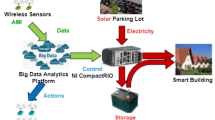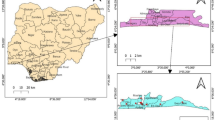Abstract
In this paper, a modified backpropagation neural network is combined with a chaos-search genetic algorithm and simulated annealing algorithm for very short term electrical energy demand prediction in deregulated power industry. Multiple modifications are carried out on the conventional backpropagation algorithm such as improvements in the momentum factor and adaptive learning rate. In the hybrid scheme, the initial parameters of the modified neural network are optimized by using the global search ability of genetic algorithm, improved by cat chaotic mapping to enrich its optimization capability. The solution set provided by the optimized genetic algorithm is further improved by using the strong local search ability of simulated annealing algorithm. The real data of New South Wales, Australian grid, is used in the experimentation for 1-h-ahead forecast with an emphasis on data analysis and preprocessing framework. The correlation analysis is used for the identification and selection of the most influential input variables. The simulation results reveal that the proposed combination technique effectively enhanced the prediction accuracy as compared to the available conventional methods. The prediction of 1-h-ahead load demand is critically important for decision-making response of the modern smart grid system. The acceptable precision of the proposed model concludes that it can be applied in the smart grid to enhance its demand responsiveness and other intelligent features.








Similar content being viewed by others
Abbreviations
- ANN:
-
Artificial neural network
- BP:
-
Backpropagation
- BPNN:
-
Backpropagation neural network
- CGA:
-
Chaotic genetic algorithm
- CGA-MdBP:
-
Chaotic genetic algorithm modified backpropagation
- CGASA-MdBP:
-
Chaotic genetic algorithm-simulated annealing modified backpropagation
- CnBP:
-
Conventional backpropagation
- DR:
-
Demand response
- GA-MdBP:
-
Genetic algorithm modified backpropagation
- ICT:
-
Information and communications technology
- IVS:
-
Input variable selection
- MAE:
-
Mean absolute error
- MAPE:
-
Mean absolute percentage error
- MSE:
-
Mean square error
- MdBP:
-
Modified backpropagation
- MLP:
-
Multilayer perceptron
- MLPNN:
-
Multilayer perceptron neural network
- NN:
-
Neural network
- SA:
-
Simulated annealing
- SG:
-
Smart grid
References
Reddy KS et al (2014) A review of integration, control, communication and metering (ICCM) of renewable energy based smart grid. Renew Sustain Energy Rev 38:180–192
Hernández L et al (2013) Improved short-term load forecasting based on two-stage predictions with artificial neural networks in a microgrid environment. Energies 6(9):4489–4507
Alfares HK, Nazeeruddin M (2002) Electric load forecasting: literature survey and classification of methods. Int J Syst Sci 33(1):23–34
Kandil N et al (2006) An efficient approach for short term load forecasting using artificial neural networks. Int J Electr Power Energy Syst 28(8):525–530
Bhatt J, Shah V, Jani O (2014) An instrumentation engineer’s review on smart grid: critical applications and parameters. Renew Sustain Energy Rev 40:1217–1239
Górriz JM et al (2004) A new model for time-series forecasting using radial basis functions and exogenous data. Neural Comput Appl 13(2):101–111
Marín F, Sandoval F (1997) Short-term peak load forecasting: statistical methods versus artificial neural networks. In: Biological and artificial computation: from neuroscience to technology. Springer, Berlin, Heidelberg, pp 1334–1343
Yun K et al (2012) Building hourly thermal load prediction using an indexed ARX model. Energy Build 54:225–233
Asber D et al (2007) Non-parametric short-term load forecasting. Int J Electr Power Energy Syst 29(8):630–635
Lowry G, Bianeyin FU, Shah N (2007) Seasonal autoregressive modelling of water and fuel consumptions in buildings. Appl Energy 84(5):542–552
Wu J et al (2013) Short term load forecasting technique based on the seasonal exponential adjustment method and the regression model. Energy Convers Manag 70:1–9
Chakhchoukh Y, Panciatici P, Mili L (2011) Electric load forecasting based on statistical robust methods. IEEE Trans Power Syst 26(3):982–991
Rahman S, Hazim O (1996) Load forecasting for multiple sites: development of an expert system-based technique. Electr Power Syst Res 39(3):161–169
Sarrias-Mena R et al (2014) Fuzzy logic based power management strategy of a multi-MW doubly-fed induction generator wind turbine with battery and ultracapacitor. Energy 70:561–576
Chan ZSH et al (2006) Short-term ANN load forecasting from limited data using generalization learning strategies. Neurocomputing 70(1–3):409–419
Ahmadizar F et al (2015) Artificial neural network development by means of a novel combination of grammatical evolution and genetic algorithm. Eng Appl Artif Intell 39:1–13
Suganthi L, Samuel AA (2012) Energy models for demand forecasting—a review. Renew Sustain Energy Rev 16(2):1223–1240
Catoni O (1996) Metropolis, simulated annealing, and iterated energy transformation algorithms: theory and experiments. J Complex 12(4):595–623
Liu Z, Sun W, Zeng J (2013) A new short-term load forecasting method of power system based on EEMD and SS-PSO. Neural Comput Appl 24(3):973–983
Abd-Elazim SM, Ali ES (2013) Power system stability enhancement via bacteria foraging optimization algorithm. Arab J Sci Eng 38(3):599–611
Holland JH (1992) Adaptation in natural and artificial systems: an introductory analysis with applications to biology, control, and artificial intelligence. MIT press, Cambridge, MA
Oshaba A, Ali E (2014) Bacteria foraging: a new technique for speed control of DC series motor supplied by photovoltaic system. Int J WSEAS Trans Power Syst 9:185–195
Ali E, Abd-Elazim S (2013) Synergy of particle swarm optimization and bacterial foraging for SSSC damping controller design. Int J WSEAS Trans Power Syst 8(2):74–84
Yang Y, Zheng G, Liu D (2001) BP-GA mixed algorithms for short-term load forecasting. 0-7803-70 10-4/01/IEEE
Zhangang Y, Yanbo C, Cheng KE (2007) Genetic algorithm-based RBF neural network load forecasting model. In: Power engineering society general meeting, 2007. IEEE
Yu F, Xu X (2014) A short-term load forecasting model of natural gas based on optimized genetic algorithm and improved BP neural network. Appl Energy 134:102–113
Ling S et al (2002) Short-term daily load forecasting in an intelligent home with GA-based neural network. In: Proceedings of the 2002 international joint conference on neural networks, 2002 IJCNN’02. IEEE
Liao G-C, Tsao T-P (2006) Application of a fuzzy neural network combined with a chaos genetic algorithm and simulated annealing to short-term load forecasting. IEEE Trans Evol Comput 10(3):330–340
Yang K-H, Shan G-L, Zhao L-L (2006) Correlation coefficient method for support vector machine input samples. In: International conference on machine learning and cybernetics, 2006. IEEE
Xiao L et al (2015) A hybrid model based on data preprocessing for electrical power forecasting. Int J Electr Power Energy Syst 64:311–327
de Aquino RR et al (2006) Combining artificial neural networks and heuristic rules in a hybrid intelligent load forecast system. In: Artificial neural networks—ICANN 2006. Springer, pp 757–766
Jing G, Du W, Guo Y (2012) Studies on prediction of separation percent in electrodialysis process via BP neural networks and improved BP algorithms. Desalination 291:78–93
Simon H (2009) Neural networks and learning machines. Pearson International Edition, Pearson, Bostan, MA, p 282
Nayak S, Misra B, Behera H (2012) Index prediction with neuro-genetic hybrid network: a comparative analysis of performance. In 2012 International conference on computing, communication and applications (ICCCA). IEEE
Zhangang Y, Yanbo C, Cheng KE (2007) Genetic algorithm-based RBF neural network load forecasting model. In: Power Engineering Society General Meeting. IEEE, pp 1–6
Shapiro AF (2002) The merging of neural networks, fuzzy logic, and genetic algorithms. Insur Math Econ 31(1):115–131
Ghayekhloo M, Menhaj M, Ghofrani M (2015) A hybrid short-term load forecasting with a new data preprocessing framework. Electr Power Syst Res 119:138–148
Wang J-J et al (2012) Stock index forecasting based on a hybrid model. Omega 40(6):758–766
Acknowledgments
The authors wish to thank Universiti Teknologi PETRONAS for providing the research Grant (Number URIF 0153AA-B13) to conduct this research.
Author information
Authors and Affiliations
Corresponding author
Rights and permissions
About this article
Cite this article
Islam, B., Baharudin, Z. & Nallagownden, P. Development of chaotically improved meta-heuristics and modified BP neural network-based model for electrical energy demand prediction in smart grid. Neural Comput & Applic 28 (Suppl 1), 877–891 (2017). https://doi.org/10.1007/s00521-016-2408-3
Received:
Accepted:
Published:
Issue Date:
DOI: https://doi.org/10.1007/s00521-016-2408-3




